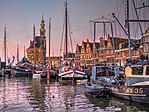Zwaagdijk-West
MedemblikNorth Holland geography stubsPages with Dutch IPAPages with non-numeric formatnum argumentsPopulated places in North Holland

Zwaagdijk-West (Dutch pronunciation: [ˈzʋaːɣdɛik ˈʋɛst]) is a village in the Dutch province of North Holland. It is a part of the municipality of Medemblik, and lies about 3 km north of Hoorn. The village was first mentioned in 1319 as buten den Zuoechdyc, and means "the dike belonging to Zwaag. Zwaagdijk-Oost is the settlement on the eastern side of the dike, Zwaagdijk-West is on the western side. In 1929, the Catholic Jacobus de Meerdere Church was built in Zwaagdijk-West.
Excerpt from the Wikipedia article Zwaagdijk-West (License: CC BY-SA 3.0, Authors, Images).Zwaagdijk-West
Zwaagdijk, Medemblik
Geographical coordinates (GPS) Address Nearby Places Show on map
Geographical coordinates (GPS)
| Latitude | Longitude |
|---|---|
| N 52.675833333333 ° | E 5.0591666666667 ° |
Address
Zwaagdijk 375
1685 PC Medemblik
North Holland, Netherlands
Open on Google Maps










